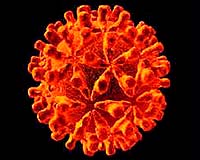| . |  |
. |
Geneva (AFP) Oct 12, 2009 About 100 developing countries will receive international donations of swine flu vaccines, maybe as soon as November, a World Health Organisation official said Monday. "The director general of WHO will approve most likely today a list of countries for the donations," said Marie-Paule Kieny, who heads the WHO's vaccine research unit. "The list will include about 100 countries," she told journalists. "We are trying to have the first deliveries in November." Dozens of millions of doses are being lined up following offers from pharmaceutical companies as well as a US-led group of rich nations that have pledged to release 10 percent of their vaccine purchases for poor nations. It will include about 150 million doses from two makers Sanofi-Aventis and GlaxoSmithKline (GSK), as well as an as yet unspecified amount from a third supplier, Medimmune, in the form of a nasal spray and the rich nation stocks, Kieny said. The donations to counter the threat from the flu pandemic that emerged in April would be directed to low and some middle income countries. The deliveries should target about two percent of the population there over the next four or five months, beginning with health workers and followed by other vulnerable groups, she added. Kieny also said global influenza A(H1N1) vaccine production should be higher than feared a few weeks ago, although she did not change the overall production capacity of about three billion doses estimated by the WHO last month. "We have good news. Although it seems the yields with the latest vaccine viruses provided to the manufacturers... are not as good as with seasonal flu, there has been a marked increase in the yields," she explained. "We are reaching a situation where availability of vaccine will be higher than what was feared a few weeks ago." Just two weeks ago, WHO chief Margaret Chan had cut the estimated global production capacity from five billion doses to three billion a year, mainly due to poorer than expected yields from "seed virus" strains used to make the vaccine. Kieny reiterated that just one dose was sufficient to provide immunity and insisted that there was no reason to doubt the safety of the swine flu vaccines approved by regulators or their ingredients. After 100,000 vaccinations in China, just one in 1,000 recipients developed "mild" side-effects such as a pain in the arm after the jab or a bout of fever, according to the WHO. The proportion so far was "actually quite low," said Kieny. The UN health agency had already announced plans to supply developing nations with the vaccines they often cannot afford to buy, and the donations, in recent months. But it has gradually increased the number of countries targeted. The agency's group of independent experts on immunisation, known as SAGE, is due to hold its regular meeting on October 27 to 29, partly to discuss A(H1N1) vaccinations. Share This Article With Planet Earth
Related Links Epidemics on Earth - Bird Flu, HIV/AIDS, Ebola
 China to stop mandatory hepatitis B tests: state media
China to stop mandatory hepatitis B tests: state mediaBeijing (AFP) Oct 11, 2009 China will stop mandatory hepatitis B tests for employees joining new companies and students enrolling in schools, state media said Sunday, after a court ruled the tests were illegal discrimination. Deng Haihua, deputy director of the health ministry's general office, said the government would soon issue instructions to stop the practice, which is currently a requirement, the official ... read more |
|
| The content herein, unless otherwise known to be public domain, are Copyright 1995-2009 - SpaceDaily. AFP and UPI Wire Stories are copyright Agence France-Presse and United Press International. ESA Portal Reports are copyright European Space Agency. All NASA sourced material is public domain. Additional copyrights may apply in whole or part to other bona fide parties. Advertising does not imply endorsement,agreement or approval of any opinions, statements or information provided by SpaceDaily on any Web page published or hosted by SpaceDaily. Privacy Statement |